
Clematis is a genus of about 380 species within the buttercup family, Ranunculaceae. Their garden hybrids and cultivars have been popular among gardeners, beginning with Clematis 'Jackmanii', a garden standby since 1862; more cultivars are being produced constantly. They are mainly of Chinese and Japanese origin.
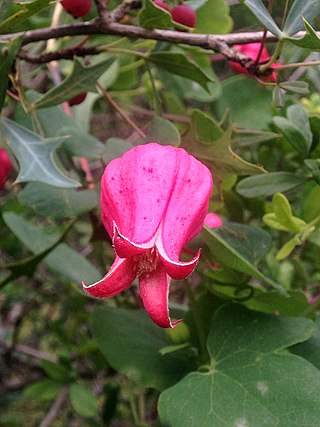
Clematis texensis, commonly called scarlet leather flower, is a climbing vine in the buttercup family (Ranunculaceae). It is native to the United States, where it is endemic to the Edwards Plateau of Texas. Its natural habitat is on rocky limestone cliffs and streamsides.

Clematis virginiana is a vine of the Ranunculaceae native to North America from Newfoundland to southern Manitoba down to the Gulf of Mexico. The rationale for some of the common names is unclear, as they include examples normally applied to unrelated plants, including twining parasites. The name "Love Vine" also is applied to alleged aphrodisiacs, such as Caribbean species of Cassytha, which are unrelated to Clematis, not being in the family Ranunculaceae.
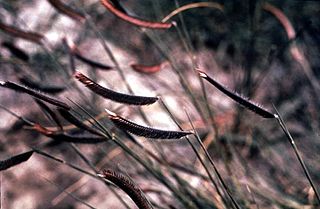
Bouteloua gracilis, the blue grama, is a long-lived, warm-season (C4) perennial grass, native to North America.

Cirsium pitcheri, sometimes called Pitcher's thistle or dune thistle, is a species of thistle native to sand dune shorelines along the upper Great Lakes. It is native to Indiana, Illinois, Michigan, Wisconsin, and Ontario. It is listed by the U.S. Fish and Wildlife Service as a threatened species.

Monarda fistulosa, the wild bergamot or bee balm, is a wildflower in the mint family Lamiaceae, widespread and abundant as a native plant in much of North America. This plant, with showy summer-blooming pink to lavender flowers, is often used as a honey plant, medicinal plant, and garden ornamental. The species is quite variable, and several subspecies or varieties have been recognized within it.

Clematis ligusticifolia is a climbing, spreading vine with showy flowers. It is also known as Old-man's Beard and Yerba de Chiva, and Virgin's bower,. It is native to North America where it is widespread across the western United States in streamside thickets, wooded hillsides, and coniferous forests up to 8,500 feet (2,600 m).

Ambrosia acanthicarpa is a North American species of bristly annual plants in the family Asteraceae. Members of the genus Ambrosia are called ragweeds. The species has common names including flatspine bur ragweed, Hooker's bur-ragweed, annual burrweed, annual bur-sage, and western sand-bur. The plant is common across much of the western United States and in the Prairie Provinces of Canada.

Clematis pauciflora is a species of clematis known by the common name ropevine. This flowering plant is native to the high desert and chaparral slopes of southern California and Baja California. It is a woody vine with nodes every few centimeters which produce leaves and flowers. The leaves are made up of several dark green lobed leaflets, each one to three centimeters wide. From each leaf-bearing node grows an inflorescence of one to three flowers with narrow petallike sepals in shades of light yellow. Most of the flower is made up of a spray of up to 50 stamens and almost as many similar-looking pistils. The fruit is an achene equipped with a long plume-like style. The specific epithet pauciflora is Latin for 'few-flowered'.

Oenothera suffrutescens is a species of flowering plant in the evening primrose family known as scarlet beeblossom and scarlet gaura.
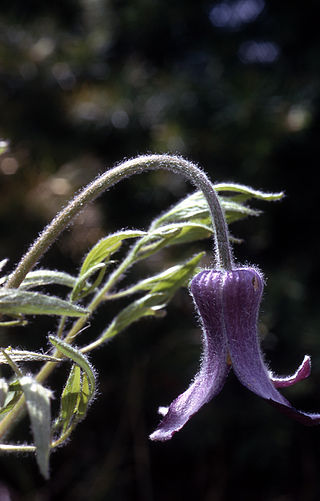
Clematis hirsutissima is a species of flowering plant in the buttercup family known by the common name hairy clematis or vase flower. It is a perennial herb that is native to much of the western United States, from Washington to Nebraska. It is a small, erect plant which, unlike other Clematis, does not generally produce vines. It is quite variable in appearance, especially across varieties. In general the hairy stem reaches up to about half a meter tall and has many large hairy leaves divided into lance-shaped lobes. The inflorescence appears at the tip of the stem and bears a solitary flower. The flower is made up of an urn-shaped cup of deep purple-blue petal like sepals, which are fuzzy and have pointed or rounded tips. Rare individuals have white or pinkish sepals. There are no true petals. The fruit is a hairy achene with a very long beak and a plume on the end; it is dispersed by wind.

Ceanothus americanus is a species of Ceanothus shrub native to North America. Common names include New Jersey tea, Jersey tea ceanothus, variations of red root, mountain sweet, and wild snowball. New Jersey tea was a name coined during the American Revolution, because its leaves were used as a substitute for imported tea.
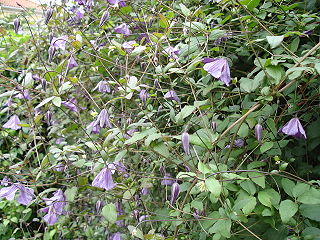
Clematis viticella, the Italian leather flower, purple clematis, or Virgin's bower, is a species of flowering plant in the buttercup family Ranunculaceae, native to Europe. This deciduous climber was the first clematis imported into English gardens, where it was already being grown in 1569 by Hugh Morgan, apothecary to Elizabeth I. By 1597, when it was already being called "Virgin's Bower", there were two varieties in English gardens, a blue and a red.

Clematis morefieldii is a rare species of flowering plant in the buttercup family known by the common names Morefield's leather flower and Huntsville vasevine.
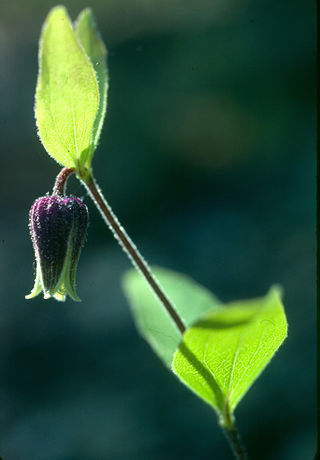
Clematis viticaulis is a species of flowering plant in the buttercup family known by the common names Millboro leatherflower and grape clematis.

Sabatia kennedyana is a species of flowering plant in the gentian family known by the common name Plymouth rose gentian. It is native to eastern North America. It has a disjunct distribution, occurring in Nova Scotia, Massachusetts, Rhode Island, Virginia, North Carolina, and South Carolina.
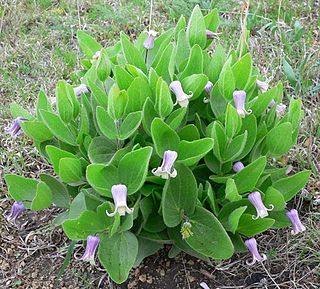
Clematis fremontii is a species of flowering plant in the buttercup family known as Fremont's leather flower. It is endemic to the United States where it is known from several disjunct populations throughout the central and southeastern states. Previously unknown populations were discovered in the mid-2000s in Tennessee and Georgia. Other names for this plant include Fremont's crowsfoot, Fremont's leather-plant, leatherplant, and rattleweed.

Clematis crispa is a species of flowering plant in the buttercup family known by the common name swamp leatherflower. It is found in southeastern United States.

Mertensia lanceolata, known as prairie bluebells, narrow-leaved languid lady, lance-leaved bluebells, and lance-leaved lungwort is a species of flowering plant native to western North America. A herbaceous perennial it has blue-green leaves alternately arranged on its smooth flowering stalk. Its flower buds are pink-purple and become more blue as they open. Accepted varieties include:

The Rogerson Clematis Garden is a botanical garden located at Luscher Farm Park near Lake Oswego, Oregon. The garden is roughly 1-acre (0.40 ha) in size and is home to the Rogerson Clematis Collection, a Nationally Accredited Plant Collection consisting of more than 2,000 individual clematis plants. It represents nearly 900 distinct species or cultivars from around the world, including rare and historic hybrids, American species, and recent introductions.





















